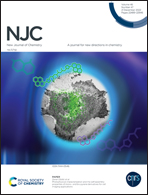Evaluation and degradation mechanism of phthalimide derivatives as anolytes for non-aqueous organic static batteries†
Abstract
In organic flow batteries, understanding of the in depth charge storage mechanism is in the immature stage, and is required for the design of efficient electrode materials. Herein we report a non-aqueous static organic battery comprising phenothiazine and phthalimide derivatives as the active electrolytes. We studied different derivatives of phthalimide to explore electrolyte stability during prolonged cycling experiments. Among the prepared derivatives 4-tertiary butyl phthalimide was found to be an excellent candidate with an output voltage of ∼1.4 V with excellent capacity retention and coulombic efficiency as well as good rate performance. The initial capacity for the tertiary butyl derivative was found to be 18.3 mA h at the 141st cycle and remained at 15.1 mA h with ∼18% capacity fade after 100 continuous cycles. The observed capacity was found to be 18.6, 17.1, 14.2, 11.5 and 9.8 mA h for current densities of 20, 30, 40, 50 and 75 mA cm−2 respectively. The current was reversed to evaluate the rate reversibility in which the capacities were found to be 18.4, 16.8, 11 and 9.6 mA h respectively at 20, 30, 40 and 50 mA cm−2. The rate stability, rate reversibility and cycling stability were found to be excellent compared with the other derivatives. The degradation mechanism was studied by NMR, LCMS and UV-visible spectral analysis. Radical self-coupling of the electrode material would be an asset if the capacity of the material would not be affected to a considerable extent. In our case the dimerization of the radical resulted in no loss of the redox-active functional group, however the number of OH groups and the molecular weight of the material were increased. The extensive H-bonding stabilized the material and inhibited the unwanted cross over of the electrolytes.



 Please wait while we load your content...
Please wait while we load your content...